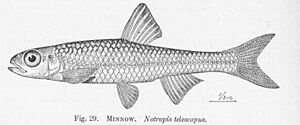Telescope shiner facts for kids
Quick facts for kids Telescope shiner |
|
|---|---|
 |
|
| Conservation status | |
| Scientific classification | |
| Synonyms | |
|
Photogenis telescopus Cope, 1868 |
The telescope shiner (Notropis telescopus) is a type of ray-finned fish. It belongs to a group of fish called Notropis, which are often called shiners. This fish gets its name because it has very large eyes, like a telescope!
You can mostly find the telescope shiner in a small area of the southeastern United States. It lives in parts of the Tennessee and Cumberland river systems. This includes states like Virginia, Kentucky, Tennessee, and Alabama. There's also another group of these fish in Arkansas and Missouri, in the White and Black rivers.
Contents
What Does It Look Like?
The telescope shiner is named for its big eyes. These eyes are much larger than those of other shiner fish. Adult telescope shiners usually grow to be about 50 to 105 millimeters long. That's about 2 to 4 inches! Unlike some other shiners, this fish doesn't have any super bright or special colors. It tends to be more plain.
Where Does It Live?
Telescope shiners like to live in cool, clear water. They prefer places like fast-moving streams and small rivers. You can find them in different parts of these waterways. They live in areas where the water flows quickly over rocks (called riffles). They also live in smoother, flowing parts (runs) and deeper, calm areas (pools).
These fish can do well in water that has certain qualities. They are fine with water that has higher levels of pH (how acidic or basic water is). They also like water with more alkalinity, magnesium, and dissolved oxygen.
What Do They Eat?
The telescope shiner is an insectivore. This means it mainly eats insects. It probably catches small insects that live in the water or fall onto the surface.
Life Cycle and Reproduction
Telescope shiners are known as "lithophil" spawners. This means they like to lay their eggs on open rocks and gravel. The baby fish, called embryos, hatch quickly. After hatching, they stay hidden safely under the rocks.
These fish lay eggs multiple times during their spawning season. This season usually happens between April and July. During this time, the fish's reproductive organs grow larger and are ready for spawning.
How Are They Protected?
Government groups help keep an eye on telescope shiner populations. They also work to manage their habitats. These efforts are usually part of bigger studies. These studies look at the overall health of streams and river systems. They don't just focus on the telescope shiner, but on all the living things in the water. This helps make sure the telescope shiner and other fish have healthy places to live.


